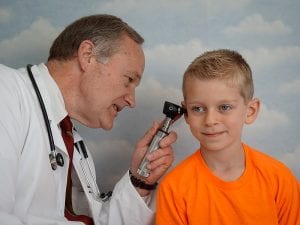Ear Infection (Acute Otitis Media)

What it is
- bulging of the ear drum, or tympanic membrane
- cloudy fluid behind the ear drum, called middle ear infection.
- not a swimmer’s ear, ie water going into the ear canal, from a bath or pool, cannot cause a middle ear infection, but instead may cause swimmers ear or outer ear infection
Symptoms a child may show are
- pulling or poking in the ears, holding the hands near the ears
- increased fussiness, less playfulness, and decreased appetite.
- mild vomiting and/or diarrhea.
- none at all.
The majority of infants and toddlers will have at least one ear infection before the age of 2 years.
Factors that lead to middle ear infections are
- more frequent colds
- anatomy of the ear, nose, and throat that promotes mucous or fluid pooling in the middle ear space.
- pooling of fluid leads to the overgrowth of bacteria
- this leads to the inflammation of the anatomical parts
- fluid and bacteria not able to drain out of the middle ear
As the children get older, the ear infection may clear on its own some of the time.
Other factors that may increase the occurrence of ear infections are
- feeding while lying back
- smoking in the environment, including in the car.
- presence of allergy symptoms.
- possibly pacifier use.
Treatments that will likely help are
- Tylenol or Motrin/Advil (>6mos age)
- Antibiotics, but not always necessary
Tubes may be recommended if
- fluid is noted in the middle ear for a prolonged period of time.
- repeated ear infections in a short period of time.
- ear infections that show no resolution.
- hearing deficit or learning/language delays are noted.
Follow up
- Because middle ear fluid may persist.
- Because hearing and language delays occur after ear infections.
Call our office at any time for concerns, day or night, 910-484-3121.

